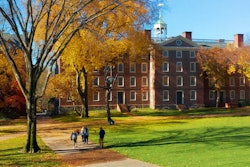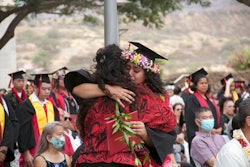WASHINGTON, D.C. — As immigration and population growth continue to reshape the demographic landscape of the United States, college and university leaders should pay closer attention to the growing number of their Asian-American and Pacific Islander students.
That was the crux of the message delivered Tuesday on Capitol Hill in conjunction with the release of the 2011 report of the National Commission on Asian American and Pacific Islander Research in Education, or CARE.
Among other things, the report, titled The Relevance of Asian Americans & Pacific Islanders in the College Completion Agenda , provides a more nuanced picture of the enrollment and degree completion rates of Asian-American and Pacific Islander students. Panelists contended that this group of students often gets lumped together as “Asians” and are often regarded as likely to do well in college because of notions of academic giftedness that are wrongly ascribed to all students of Asian descent.
The reality, says the report’s lead author, Dr. Robert Teranishi, associate professor of higher education at New York University, is that Asian-American and Pacific Islander students are unlike any other racial group in the United States in terms of their heterogeneity, which involves 48 different ethnic groups, more than 300 languages and a wide variety of histories, cultures and religions.
Understanding the variation in their socioeconomic backgrounds is key to ensuring their academic success, Teranishi said.
“If we do nothing, we have to think about what the consequences of that will be,” Teranishi said.
To illustrate the point, Teranishi highlighted statistics that showed wide variation in educational attainment among various ethnic subgroups within Asian-American and Pacific Islander college students.
At the higher end of degree attainment for Asian-American students were Asian Indian, Chinese, Pakistani, Korean, Thai, Japanese and Filipino students, whose bachelor’s degree attainment rates were at about 40 percent or better.
However, the bachelor’s degree attainment rates are significantly lower — in the 25 to 37 percent range — among Indonesian, Vietnamese, Cambodian, Laotian and Hmong students.
Completion rates were lower still for Pacific Islander students, namely, Guamanian, Native Hawaiian, Tongan and Samoan students, whose bachelor degree completion rates were in the 14 to 25 percent range, according to the report.
Teranishi said the statistics often lead to a debate about whether Asian-American and Pacific Islander students need to adapt to meet the expectations of colleges and universities, or whether colleges and universities need to do more to better serve these students.
There is no one-size-fits-all approach, Teranishi said, but he recommended that leaders be pro-active about reaching out to Asian American and Pacific Islanders students on their respective campuses to learn more about their challenges.
“What I often encourage institutions to do is to take a look at who your Asian-American and Pacific Islander students are, talk to them,” Teranishi said. “What do you know about them? Are these students more likely to be concentrated in remedial education?”
Co-panelist Seataoaifalenaoti “Seata” Shyon, a first-generation college student at Smith College and an Asian & Pacific Islander American Scholarship Fund recipient, said she takes the initiative to make institutions aware of her presence on campus, but she doesn’t make a big issue about her ethnic background. She is Samoan and Vietnamese.
“I could not come into this institution and say ‘You’re supposed to support my community’” Shyon said. “They are not mindful and don’t know my background. So I let them know what my background is, and that I’m a student, and they need to support me.”
Some of the discussion focused on the Asian-American and Native American Pacific Islander-Serving Institution, or AANAPISI, federal program, a competitive grant process for institutions with at least a 10 percent enrollment of Asian-American and Pacific Islander students.
As of 2011, there were 52 such institutions that got the AANAPISI designation, but only 15 received that funding, the report noted.
Co-panelist Larry Griffith, vice president of the Gates Millennium Scholars Program at UNCF and a CARE commissioner, said making investments in AANAPISIs helps other students because it helps the institutions build capacity.
“When investments are made in an AANAPISI, investments are made in students from other diverse populations,” Griffith said. He also pointed out that AANAPISIs, just like HBCUs serve a greater proportion of the nation’s Black students than other institutions, serve a larger share of Asian American and Pacific Islander students.
Specifically, the report found, AANAPISIs enroll one in 10 Asian-American or Pacific Islander undergraduates, versus their enrollment of 1.5 percent of the nation’s total undergraduate population.
Panelist Dr. Debra Saunders-White, deputy assistant secretary for higher education programs at the Department of Education, said she often addresses inquiries from college presidents who want to know if designation as an AANAPISI precludes them from being another kind of minority-serving institution, such as a Hispanic-serving institution.
“You can’t double-dip,” Saunders-White says. However, she says, her office spends considerable time working with college presidents to help them figure out their priorities and, if they find it is not advantageous to be designated as an AANAPISI, to search for other federal programs for which they might be eligible.
Tuesday’s panel was preceded by an appearance by Rep. Mazie Hirono, D-Hawaii, who said this was a critical time to fight for more resources for Asian-American and Pacific Islander students.
She lamented that a bill recently passed the House that would eliminate 40 education programs, including several that are specific to Asian-American and Pacific Islander students, “all in the name of flexibility.”
She was referring to the Setting New Priorities in Education Spending Act. A bill summary put out by the Republican-controlled House of Representatives describes the programs as “wasteful education programs” or, in some cases, duplicative of ESEA Title I, which targets funds to disadvantaged students to increase academic achievement.
“We need to raise our collective voices,” Hirono said. “Members of Congress need to hear from you.”





















